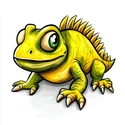How to Draw an Iguana
Learn how to draw an iguana with this step-by-step drawing tutorial. Capture the unique features of this fascinating reptile and create a stunning artwork.

Materials You'll Need
- Pencil
- Paper
- Eraser
 Welcome to our comprehensive guide on how to draw an iguana! Drawing reptiles can be both a challenging and rewarding experience, and iguanas, with their distinctive features and vibrant colors, make for an excellent subject. Whether you're an experienced artist looking to hone your skills or a beginner eager to learn the basics, this tutorial will assist you in bringing your iguana illustration to life.
Welcome to our comprehensive guide on how to draw an iguana! Drawing reptiles can be both a challenging and rewarding experience, and iguanas, with their distinctive features and vibrant colors, make for an excellent subject. Whether you're an experienced artist looking to hone your skills or a beginner eager to learn the basics, this tutorial will assist you in bringing your iguana illustration to life.
Throughout this step-by-step process, we will walk you through the essentials of capturing the unique characteristics of iguanas, from their textured skin to their striking postures. You'll learn to observe and replicate these fascinating reptiles, ensuring your drawing not only mirrors their appearance but also reflects their dynamic personalities. So gather your drawing materials and get ready to embark on your creative adventure!
Let's dive in and unleash your artistic potential as we explore the wonderful world of iguana drawing together! With patience and practice, you'll soon find yourself capable of creating stunning representations of these captivating reptiles on paper.
Materials Required
Before we begin, make sure you have the following materials:
- Pencil: Use a pencil with a medium lead for sketching and shading.
- Sketching paper: Choose a smooth, heavyweight paper that can handle multiple layers of pencil work.
- Eraser: Use a kneaded eraser for easy removal of mistakes and smudges.
- Blending stump/tortillon: This tool will help you achieve smooth shading and blending.
- Reference image: Find a clear and detailed reference image of an iguana to aid in your drawing.
Now that you have all the necessary materials, let's dive into the step-by-step instructions.
Step 1: Basic Shape
Start by lightly sketching a basic shape for the iguana's body using simple geometric forms. Begin with an oval shape for the head, followed by a triangular shape for the body and a long curved line for the tail. Keep the lines light and loose, as they will serve as a guideline for the final drawing.
Step 2: Head Details
Refine the shape of the head by adding more detail. Sketch the eyes, using almond shapes with a small circle for the iris. Add a ridge above the eyes, which is a prominent feature in iguanas. Include the nostril holes and a triangular mouth, slightly open to reveal the teeth. Don't forget the small scales that cover the iguana's head.
Step 3: Body and Limbs
Using the triangular shape as a guide, add more definition to the body. Sketch in the front and hind limbs, making sure to capture their proportion and alignment. Add the details of the iguana's claws at the end of each limb. Remember to include the scales along the body, paying attention to their size and pattern.
Step 4: Tail
Define the tail by adding its unique shape and texture. Iguanas have a long and muscular tail with small, overlapping scales. Use curved lines to create a sense of volume and dimension. Pay attention to the tapering of the tail as it narrows towards the end.
Step 5: Shading
Now it's time to add depth and realism to your drawing through shading. Start by identifying the light source and imagine how it falls on the iguana's body. Use light, even strokes to shade the darker areas, such as the undersides, crevices, and areas in shadow. Gradually build up the layers of shading, using a combination of hatching, cross-hatching, and blending techniques.
Step 6: Textures and Details
To enhance the realism of your iguana drawing, focus on adding textures and details. Pay attention to the scales on the iguana's body and tail, using short, curved lines to represent them. Add wrinkles and folds around the iguana's neck and body to give it a lifelike appearance. Don't forget to add fine details like the iguana's claws, teeth, and the rough texture of its skin.
Step 7: Final Touches
Evaluate your drawing and make any necessary adjustments. Erase any stray lines or smudges with a kneaded eraser. Enhance the highlights and dark areas to create a sense of contrast and depth. Take a step back and observe your drawing from a distance to ensure overall balance and proportion.
Tip: To effectively capture the unique texture of an iguana's skin, consider using a combination of fine and broad-tipped tools. Start with a light pencil sketch to outline the iguana's form, paying close attention to the curvature of its body and the placement of its limbs. Once you're satisfied with your sketch, switch to textured drawing tools like a blending stump or a fine-tipped pen to create detailed scales. For added depth, layer your colors with colored pencils or watercolors, focusing on the vibrant greens, blues, and earthy tones typical of iguanas. Remember to observe reference images closely to replicate their distinctive features, such as the spiny crest and the subtle variations in color across different areas of their body. Happy drawing!
Wrapping up How to Draw an Iguana
Congratulations! You've successfully learned how to draw an iguana in a realistic manner. By following these step-by-step instructions and using the right techniques, you've created a stunning representation of this fascinating reptile. Remember to practice regularly and experiment with different materials and styles to further develop your artistic skills. Enjoy the process of drawing, and keep exploring the wonderful world of art!